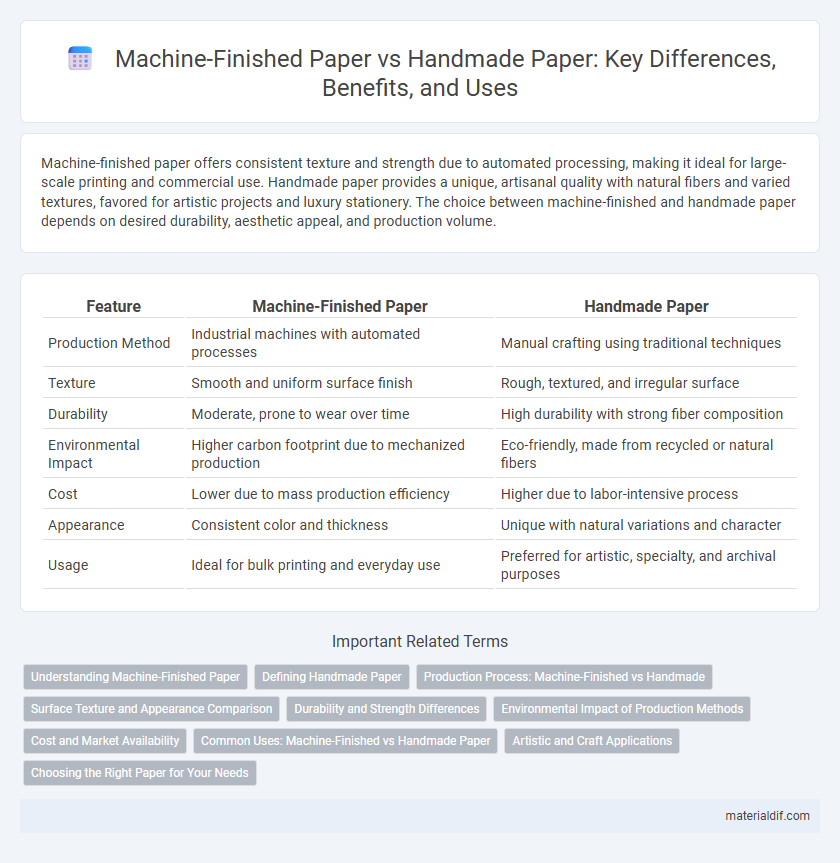Machine-finished paper offers consistent texture and strength due to automated processing, making it ideal for large-scale printing and commercial use. Handmade paper provides a unique, artisanal quality with natural fibers and varied textures, favored for artistic projects and luxury stationery. The choice between machine-finished and handmade paper depends on desired durability, aesthetic appeal, and production volume.
Table of Comparison
| Feature | Machine-Finished Paper | Handmade Paper |
|---|---|---|
| Production Method | Industrial machines with automated processes | Manual crafting using traditional techniques |
| Texture | Smooth and uniform surface finish | Rough, textured, and irregular surface |
| Durability | Moderate, prone to wear over time | High durability with strong fiber composition |
| Environmental Impact | Higher carbon footprint due to mechanized production | Eco-friendly, made from recycled or natural fibers |
| Cost | Lower due to mass production efficiency | Higher due to labor-intensive process |
| Appearance | Consistent color and thickness | Unique with natural variations and character |
| Usage | Ideal for bulk printing and everyday use | Preferred for artistic, specialty, and archival purposes |
Understanding Machine-Finished Paper
Machine-finished paper is produced using automated processes that ensure uniform texture, consistency, and thickness, making it ideal for mass production and commercial use. The paper undergoes surface treatment through calendering or coating machines to enhance smoothness and printability, resulting in high-quality finishes suitable for magazines, brochures, and office stationery. Its cost-effectiveness, durability, and scalability distinguish machine-finished paper from handmade alternatives, which emphasize artisanal techniques and unique textures.
Defining Handmade Paper
Handmade paper is crafted using traditional techniques involving manual pulping, sheet formation, and drying processes that create unique textures and natural irregularities. Its fibers are typically longer and less processed than those in machine-finished paper, resulting in enhanced durability and a distinctive tactile quality. The artisanal production methods emphasize ecological sustainability and cultural heritage, distinguishing handmade paper from mass-produced machine-finished alternatives.
Production Process: Machine-Finished vs Handmade
The production process of machine-finished paper involves automated machinery that produces uniform sheets through continuous pulp processing and pressing, enabling high-volume output with consistent texture and thickness. Handmade paper is crafted manually by dipping a frame into a pulp vat, resulting in unique, textured sheets with natural variations due to the artisanal technique. Machine-finished paper emphasizes precision and speed, while handmade paper highlights craftsmanship and individual character in each sheet.
Surface Texture and Appearance Comparison
Machine-finished paper features a smooth, uniform surface texture with consistent weight and thickness, ideal for high-volume printing and sharp image reproduction. Handmade paper exhibits a unique, tactile surface with natural irregularities and visible fibers, offering a distinct aesthetic valued in artisanal and artistic applications. The appearance of machine-finished paper is typically more polished and glossy, while handmade paper provides a rustic, organic look with varied texture patterns.
Durability and Strength Differences
Machine-finished paper typically exhibits higher strength and durability due to its uniform fiber distribution and mechanical processing, which enhance resistance to tearing and wear. Handmade paper, while often more textured and aesthetically unique, generally has weaker fiber bonds, making it more prone to damage over time. The controlled manufacturing process of machine-finished paper ensures consistent thickness and resilience, ideal for applications requiring longevity and robustness.
Environmental Impact of Production Methods
Machine-finished paper production typically involves higher energy consumption and chemical usage, leading to increased carbon emissions and water pollution compared to handmade paper. Handmade paper production relies on manual processes and often utilizes recycled or natural fibers, reducing its carbon footprint and minimizing environmental damage. Consequently, handmade paper presents a more sustainable alternative by lowering resource consumption and promoting eco-friendly practices in paper manufacturing.
Cost and Market Availability
Machine-finished paper offers significantly lower production costs due to automated manufacturing processes, making it widely available and affordable in global markets. Handmade paper involves labor-intensive craftsmanship, resulting in higher costs and limited market availability, often targeting niche or artisanal segments. The price disparity reflects differences in production scale, with machine-finished paper dominating mass-market demand while handmade paper appeals to premium and specialty markets.
Common Uses: Machine-Finished vs Handmade Paper
Machine-finished paper is widely used for commercial printing, office documents, and packaging due to its smooth surface and consistent quality. Handmade paper, valued for its unique texture and durability, is commonly preferred in fine arts, calligraphy, and luxury stationery. The choice between these types depends on the desired aesthetic and functional requirements of the project.
Artistic and Craft Applications
Machine-finished paper offers consistent texture and uniform sheets, ideal for mass-produced art prints and commercial craft projects requiring precision. Handmade paper features unique textures and natural fiber variations that enhance the aesthetic value of fine art, calligraphy, and bespoke stationery. Artists and crafters often choose handmade paper for its organic feel and ability to hold media distinctly, making each piece a one-of-a-kind creation.
Choosing the Right Paper for Your Needs
Machine-finished paper offers consistent texture, durability, and affordability, making it ideal for everyday printing and mass production tasks. Handmade paper provides unique texture and aesthetic qualities, perfect for artistic projects, invitations, and specialized stationery that require a personal touch. Selecting the right paper depends on balancing factors such as budget, purpose, and desired appearance to ensure optimal results for your specific needs.
Machine-Finished Paper vs Handmade Paper Infographic

 materialdif.com
materialdif.com